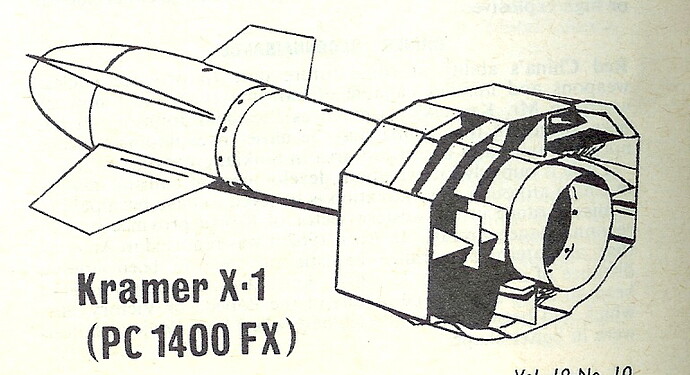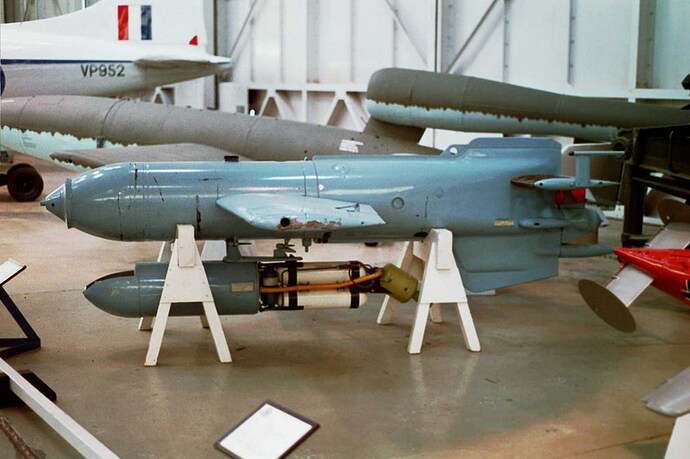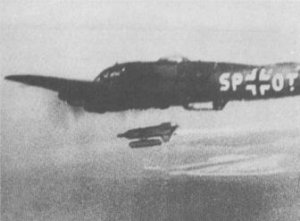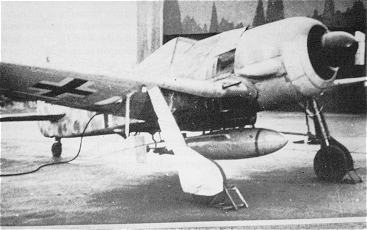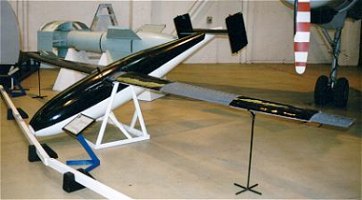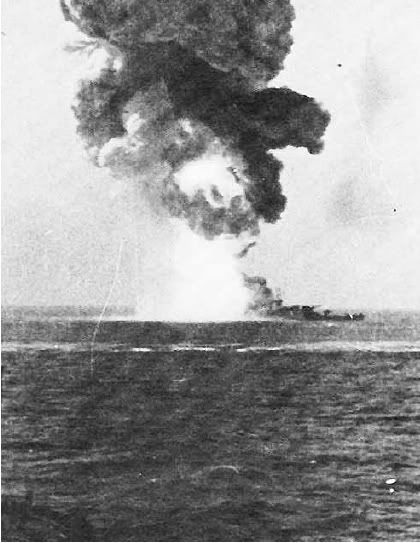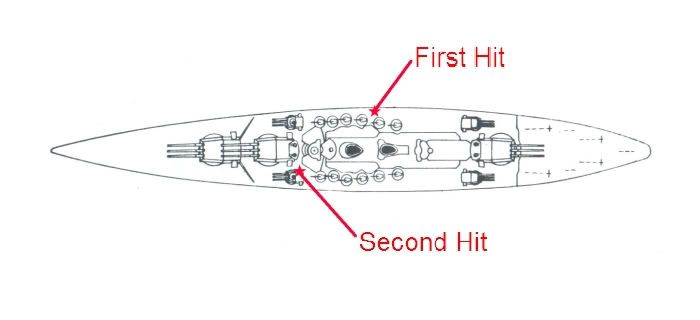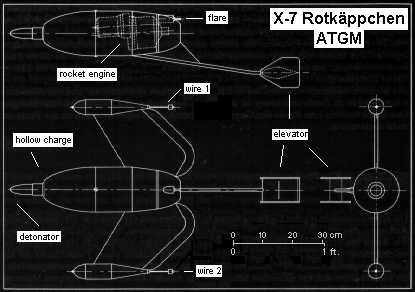The X1 (fritz X) controlled trajectory bomb.
The development of this guided bomb started pre war by Dr. Max Kramer, and tests were made with radio controlled spoilers fitted to 250 kg bombs. In 1940, the RLM got interested in Dr Kramers work, and The Ruhrstahl factories in Westfalen, in coordination with Dr Kramer, were ordered to make a guided free fall weapon system of the PC 1400 bomb for attacking ships.
Fritz X, as the weapon system was called had four centrally mounted plain cruciform fins, spanning 1,35 m. The Weapon was steered by means of electrical operated oscillating spoilers and by the rather complex tail structure. The weapon was roll stabilised by a gyroscope. In the rear section was the radio link for the control system. Like the Hs 293 missile described below there was also manufactured a wire guided system, but , like the Hs 293, the majority of weapons were radio guided. The control equipment could operate on 18 different channels, making launch of more then one weapon from a flight of planes possible without control interference
*
Like the Hs 293 the Fritz X was optically guided. There was a marker flare in the tail unit of the weapon. Using a joystick and a a Lofte 7D sight, the controller worked to keep the flare over the target. The maximum control of the weapon was about 500 meters to each side, to the initial aim of the launch had to be rather accurate. Compared to the free fall weapons of WW2, the Fritz X was accurate! A skilled operator could get 50% of the bombs with in a 15 m radius of the aiming point, and about 90% hit within 30 m radius. (Other sources say 60% hits within 4,6 meters radius)
The warhead could penetrate about 130 mm of armour before detonating. There was a micro delay fuse so the weapon detonated within the target. The explosive payload was 320 kg.
The weapon system did not work well when dropped below 5000 meters (other sources say 4000 meter) , and most operations was conducted above 6000 meters to help lessen the danger of AA fire.
This was particular important as the controlling plane had to keep flying level and reduce speed to keep the aim, so if it was within range of allied fighters or AA fire it was extremely exposed.
Testing of the weapon system started in spring 42, and a special unit, Erprobungs & lehrkommando 21 was formed in September 42 to test the weapon. Practice runs were made against old sunken target ships in the Baltic, 3 live drops pr. Aircraft crew. It was operational about the same time as the Hs 293 missile, and trough a more primitive weapon system than the missile, the Fritz X scored quite a few military successes. III/KG 100 was equipped with Fritz X mounting Doriners Ds 217 K2’s and started operation over the Mediterranean on 29 august 43.
The most famous is the sinking of the Italina Battleship Roma and the damaging of her sistership Italia on 9 September. Because of its success and fame, it will be described in detail.
The situation regarding the future faith of the still important Italian navy was tense during these autumn days. III/KG 100 was given the order to deal with the Italian navy “If it sails north, protect it, if it sails south, sink it”
On that day, KG 100 got the news that the Italian fleet had broken south. 3 Battleships, six cruisers and many small vessels were within hours of allied fighter cover. At 14.00 hours, 6 Do 217 took off from Istres, each carrying 2 Fritz X weapons and a full load of fuel. Lead by Oberlieutenant Heinrich Schmertz the bombers keeps low for about an hour before they started climbing to about 5500 meters. The Fleet group was sighted, and AA fire started rising. The Doriners kept level and reduced speed to 180 km/t. The Roma started turning. Schmdertz bomb aimer, Oscar Huhn steered a Fritz X bomb directly onto Romas front deck. Within 20 minutes the ship sank (one source claim the Roma was hit twice) Italia was damaged. Just 9 bombs dropped from high altitude had killed one battleship and damaged another! The attack on Roma killed 1254 sailors, including Admiral Bergamini.
The Luftwaffe, for resons of secrecy, claimed the hits were made by ordinary armour piercing bombs.
*
Importance of anti shipping weapons for the German war efford were increasing in the Mediterranean theatre, as the Italian fleet now was out of action on the Axis side.
Bombers carrying Fritx X bombs went into action again at Salerno, scoring several close hits and damaged the USS Savanah and several support vessels. The Cruisers HMS Uganda and HMS Warspite was also hit. The power of the Fritz X can be seen from the hit on the Warspite, 3 bombs were launched, 2 scored near misses, while the 3 penetrated 6 decks before exploding on and blowing trough the bottom of the ship. One Boiler rooms was destroyed, all steam was lost, steering was lost and armament and radar was out of function. The Warspite had to be towed to Malta for major repairs. The cruiser USS Philidelphia was also damaged and the destroyer HMS Janus was sunk.
*
*?As allied fighter cover over the bridgehead increased, Luftwaffe losses increased, and as Fritx X launching planes had to keep slow and level, they rapidly became too vulnerable and the III/KG 100 was forced to abandon it’s attacks
On April 1944 X1 bombs were launched against England for the only time, against shipping targets at Plymouth, 15 Do 217’s attacked with guided bombs, but no important targets were destroyed
It was hoped guided weapons would provide a major advantage against the expected allied invasion in France, but Allied air superiority made the slow and level approach of the guiding aircraft impossible.
?Up to December 1944 1386 bombs were made and 602 consumed in tests.
Pictures:
1-The Fritx X weapon. Drawing from flying review
2- Fritz X weapon mountedbeneath a He 177
3- Hits on the Roma
4- Hits on the Warspite. Taken from attacking German planes, shows simultaneous hits

